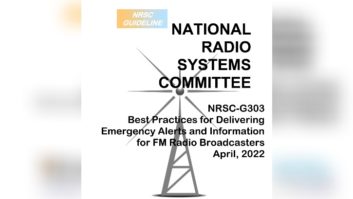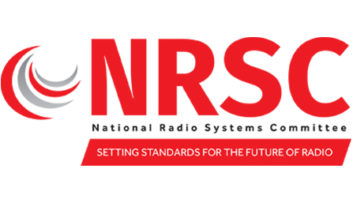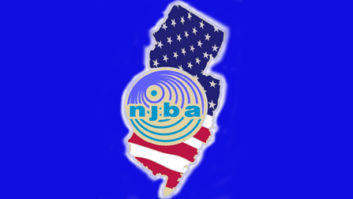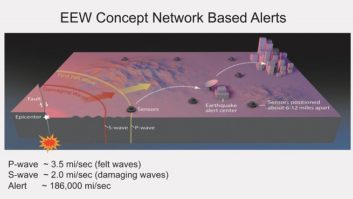
Broadcasters are expressing concerns about the notion of changing the Emergency Alert system to add or expand alerting via the internet, including via streaming.
Congress instructed the FCC to examine the feasibility of such changes and of improving alerts that are already delivered online. A notice of inquiry from the commission invited public feedback.
Feedback from broadcasters and other interested parties reflect a general wariness of modifying EAS in this way.
The majority of commenters told the FCC they worry about the practicality of enabling online alerts via streaming services. Proponents of the established system say it is proven and that alerts are available via radio and TV broadcast stations, analog and digital cable, satellite radio, cell phones and other mobile wireless devices.
In addition, some broadcasters worry that any lessening of the FCC’s regulatory jurisdiction over EAS could create enforcement issues while overseeing streaming platforms.
“Expanding emergency alerts through non-FCC regulated streaming services not only presents technological challenges, but also fundamental regulatory and compliance challenges,” iHeartMedia and Cumulus Media wrote in joint comments to the FCC.
The broadcasters expressed concerns that internet-based services such as Netflix, Spotify and Hulu operate from centralized platforms, which if enabled with emergency alert capabilities could leave them susceptible to hackers.
“An intentional hack into one of these platforms by an actor with the malicious intent to cause public panic through false emergency alerts could have very broad national impact, all outside the regulatory control of the FCC,” iHeartMedia and Cumulus wrote.
It’s also not clear how a national streaming service could receive and then geographically-target locally generated alert messages in a timely manner, they said, thus undermining the current alerting system.
“Complicated if not infeasible”
The National Association of Broadcasters expressed similar concerns in reply comments: “Extending EAS obligations to internet streaming services would be complicated, if not infeasible.”
NAB sees maintaining a “reliable EAS” as a crucial calling of all broadcasters. Reliability of alerting was one of the issues cited by Congress when it told the FCC to explore ways to coordinate multiple technologies for advanced alerting.
The NAB said the only online audio outlets that currently may retransmit EAS messages are websites and apps that simulcast radio stations.
“As a general matter, the streaming feeds at the broadcast station are originated upstream of the EAS encoder/decoder in the programming chain, meaning that an EAS alert is typically relayed only if it occurs while a station’s own programming is broadcast on-air. If an alert occurs during a commercial break in the on-air programming, when different content is inserted into the online stream, the EAS alert is not usually retransmitted to the listener or viewer,” NAB wrote.
[See Our Business and Law Page]
In addition, pure-play online content streamers are not “well-positioned to participate in the existing EAS ecosystem” for live streaming feeds or on-demand content, according to NAB. “In general, online streamers lack the infrastructure to geographically localize any alert,” it wrote.
And the association theorizes that using IP addresses to geofence the dissemination of alerts could raise even more issues.
NAB concludes: “It remains unclear how the FCC could extend the EAS rules to largely unregulated internet streamers or ensure the reliability and security of EAS over the internet. Therefore, NAB respectfully submits that the commission should report to Congress that enabling EAS alerts to consumers provided through the internet would be too complex and likely infeasible at this time.”
National Public Radio agreed with the overwhelming majority of comments in saying that streaming services should not be required to provide EAS alerts.
“NPR also asks the commission to be mindful of imposing any potential costs that would result when adopting new requirements, especially for under-resourced public broadcasting entities,” NPR wrote. “Requiring public radio stations to provide EAS alerts through internet streams could introduce cost and possibly significant complexity.”
Further, stations do not completely control the end-user player experience with their streams, and some streams have sponsorship message insertion, which can interrupt an alert, NPR pointed out.
“It would be almost impossible for a station to monitor and verify that EAS alerts air on all of the different streaming players and aggregators, so measuring and logging compliance would be difficult,” NPR said.
NPR said the NOI’s definition of “streaming services” is quite broad and included websites, applications and services that are nationally focused and stream on-demand content.
NPR did suggest that current EAS participants should be encouraged to furnish EAS alerts over the internet on a voluntary basis when feasible.
REC Networks, a low-power FM advocate, made the following observation in its comments: “As many people listen to audio streaming services through a wireless device, they already have a tool, a much more reliable tool on their phone (Wireless Emergency Alerts) that can do the same thing — if not better — than what the inquiry suggests should be imposed on small and large streaming services.”
Other views
However, the National Oceanic and Atmospheric Administration’s National Weather Service supports the efforts to extend alerts to the internet and streaming services. Specifically, it believes the use of streaming services for emergency alert information will expand message dissemination, particularly to younger audiences.
“According to the Pew Research Center, 61% of U.S. consumers aged between 18 and 29 say an online streaming service is the primary way they watch television now,” NOAA officials wrote in reply comments to the FCC.
Technology licensing company Xperi Corp. believes the nation’s digital alerting ecosystem does need “reimagining,” but rather than adopting internet capabilities, it believes the FCC should make its HD Radio technology an integral component of the digital emergency alerting fabric.
“Not only can HD Radio broadcasting serve as a model for how to integrate EAS notifications with other digital technologies, but HD Radio technology should play a central role in any efforts to modernize the EAS, providing important resiliency and redundancy,” Xperi wrote.
Xperi said HD Radio would allow for the use of Common Alerting Protocol elements that can be leveraged to render message text, graphics and audio that maximize the accessibility and effectiveness of emergency alert information.
And what about streamers?
The Digital Media Association (DiMA), whose members include pure-play online content streamers like Pandora and Spotify, believes it may be it may be feasible to complete some, but not all, steps required for end-to-end transmission of EAS alerts through the internet, specifically, via the music pure-play streaming services offered by DiMA member companies.
“While receiving and processing EAS alerts may be technically possible, however, the national and global nature of these streaming services, which operate as apps on hardware devices or through websites relying on networks these services have no control over to transmit data, makes monitoring for, retransmitting, and delivering EAS alerts to end users infeasible, if not impossible,” DiMA told the FCC.
Therefore, “rather than increasing the reach of EAS, streaming services’ involvement will duplicate and possibly interfere with activities of existing participants, including broadcasters, cable systems and telecommunications providers, and others who remain better positioned to deliver clear, targeted and relevant alerts to local communities,” DiMA wrote in its comments.
Comment on this or any article. Email [email protected].
The FCC Inquiry
The commission noted in March that Congress had instructed it to conduct an inquiry to examine the feasibility of updating the Emergency Alert System to enable or improve alerts to consumers provided through the internet, including through streaming services.
“Accordingly, in this Notice of Inquiry, we seek comment on the definition of ‘streaming services’ and whether it would be technically feasible for streaming services to complete each step that EAS participants complete under the commission’s rules in ensuring the end-to-end transmission of EAS alerts, including monitoring for relevant EAS alerts, receiving and processing EAS alerts, retransmitting EAS alerts, presenting EAS alerts in an accessible manner to relevant consumers, and testing.”
Congress also told it to look into the feasibility of improving alerts to consumers that are already delivered over the internet. “Accordingly we seek to establish whether it is feasible for EAS participants to leverage the internet to offer the full feature suite of the Common Alerting Protocol to the public.”
The NOI included many specific questions and issues that these concepts raise. You can read it in a PDF here. The discussion starts on page 26, paragraph 57.






